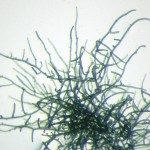Link to Pubmed [PMID] – 35944963
Link to DOI – 10.1016/j.hal.2022.102285S1568-9883(22)00113-5
Harmful Algae 2022 Aug; 117: 102285
Cyanobacterial blooms can modify the dynamic of aquatic ecosystems and have harmful consequences for human activities. Moreover, cyanobacteria can produce a variety of cyanotoxins, including microcystins, but little is known about the role of environmental factors on the prevalence of microcystin producers in the cyanobacterial bloom dynamics. This study aimed to better understand the success of Planktothrix in various environments by unveiling the variety of strategies governing cell responses to sudden changes in light intensity and temperature. The cellular responses (photosynthesis, photoprotection, heat shock response and metabolites synthesis) of four Planktothrix strains to high-light or high-temperature were studied, focusing on how distinct ecotypes (red- or green-pigmented) and microcystin production capability affect cyanobacteria’s ability to cope with such abiotic stimuli. Our results showed that high-light and high-temperature impact different cellular processes and that Planktothrix responses are heterogeneous, specific to each strain and thus, to genotype. The ability of cyanobacteria to cope with sudden increase in light intensity and temperature was not related to red- or green-pigmented ecotype or microcystin production capability. According to our results, microcystin producers do not cope better to high-light or high-temperature and microcystin content does not increase in response to such stresses.

